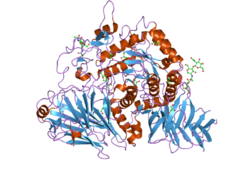Products
Online Inquiry
Our Products Cannot Be Used As Medicines Directly For Personal Use.


Welcome! For price inquiries, please feel free to contact us through the form on the left side. We will get back to you as soon as possible.
Glucoamylase
Official Full Name
Glucoamylase
Background
Glucan 1,4-alpha-glucosidase (EC 3.2.1.3, glucoamylase, amyloglucosidase (AMG), gamma-amylase, lysosomal alpha-glucosidase, acid maltase, exo-1,4-alpha-glucosidase, glucose amylase, gamma-1,4-glucan glucohydrolase, acid maltase, 1,4-alpha-D-glucan glucohydrolase) is an enzyme located on the brush border of the small intestine with systematic name 4-alpha-D-glucan glucohydrolase. This enzyme catalyses the following chemical reaction:
Hydrolysis of terminal (1->4)-linked alpha-D-glucose residues successively from non-reducing ends of the chains with release of beta-D-glucose
Most forms of the enzyme can rapidly hydrolyse 1,6-alpha-D-glucosidic bonds when the next bond in the sequence is 1,4.
Synonyms
Glucan 1#4-alpha-glucosidase; EC 3.2.1.3; glucoamylase; amyloglucosidase (AMG); gamma-amylase; lysosomal alpha-glucosidase; acid maltase; exo-1#4-alpha-glucosidase; glucose amylase; gamma-1#4-glucan glucohydrolase; acid maltase; 1#4-alpha-D-glucan glucohydrolase
| Catalog | Product Name | EC No. | CAS No. | Source | Price |
|---|---|---|---|---|---|
| EXWM-3893 | glucan 1,4-α-glucosidase | EC 3.2.1.3 | 9032-08-0 | Inquiry | |
| NATE-1308 | Glucoamylase 97A from Bacteroides thetaiotaomicron, Recombinant | EC 3.2.1.3 | 9032-08-0 | E. coli | Inquiry |
| NATE-0076 | Native Rhizopus sp. Amyloglucosidase | EC 3.2.1.3 | 9032-08-0 | Rhizopus sp. | Inquiry |
| NATE-0075 | Native Aspergillus niger Amyloglucosidase | EC 3.2.1.3 | 9032-08-0 | Aspergillus nig... | Inquiry |
| DIA-190 | Native Rhizopus sp. Glucoamylase | EC 3.2.1.3 | 9032-08-0 | Rhizopus sp. | Inquiry |
| Catalog | Product Name | EC No. | CAS No. | Source | Price |
|---|---|---|---|---|---|
| SUG-002 | Glucoamylase (Composite) (Food Grade) | Inquiry | |||
| DIS-1013 | Amyloglucosidase (Glucoamylase) | 9032-08-0 | Aspergillus niger | Inquiry | |
| ASE-3110 | Glucoamylase for fuel-alcohol | 9032-08-0 | Inquiry | ||
| ASE-3104 | Glucoamylase for Saccharification in Starch Industry | 9032-08-0 | Inquiry | ||
| BAK-1726 | Glucoamylase for baking | 9032-08-0 | Inquiry | ||
| BAK-1714 | Glucoamylase enzyme for crust | 9032-08-0 | Inquiry | ||
| BRE-1619 | Glucoamylase for light beer | 9032-08-0 | Inquiry | ||
| ALC-1516 | Glucoamylase for Alcohol Industry | 9032-08-0 | Aspergillus niger | Inquiry |
 Figure 1. Protein structure of glucoamylase.
Figure 1. Protein structure of glucoamylase.